- Home
- Margaret Atwood
On Writers and Writing
On Writers and Writing Read online
“Charming.… [Atwood] teases, probes, tickles, punches and enlightens.… She wades into mythology with … ease … and sweeps across Western literature with casual erudition. You get to see the muscle of her mind, in its leapfrogging and hopscotching, making strange and original connections veiled in playfulness.… Atwood is a writer who has scratched her name on the tablet of the English language. She belongs to the world.”
—The Globe and Mail
“What every reader wants, a learned distillation of world lit and myth as viewed by that endangered species, a working writer … entertaining, to say nothing of edifying.”
—The Miami Herald
“Atwood is … one of the most eminent women writing in English.… [She] plunges into matters that have beguiled readers and writers since Gilgamesh engraved his story on a stone.”
—The Atlanta Journal-Constitution
“A pleasure to read: erudite, talky, with a heady humour.”
—The Daily Telegraph
“Atwood’s style glistens with sharp details and sly wit. The range of references is deliciously eclectic.”
—Quill & Quire
“A bracing performance.”
—The Women’s Review of Books
“Abrim with … treasures of language.… I found hours of delight, of genial excitement—experienced with the certainty that I shall go back to it again and again for moments of joy.… The book rollicks with wonderful, breezy, confiding stuff.… I now have a book to prescribe to any and all prospective writers.”
—Michael Pakenham, The Baltimore Sun
“Engaging food for thought for all those who care about writers and writing.… Atwood allows her wit to shine on almost every page.”
—Library Journal
“This interesting and compelling book is as wise as it is charming, and it is very charming indeed.… [It] is a book of breathtaking sincerity … but spunky and fun, particularly if your idea of fun is to ask some very hard questions.”
—The Washington Post Book World
“A refreshing change from other books on writing.”
—The Columbus Dispatch
BOOKS BY MARGARET ATWOOD
FICTION
The Edible Woman (1969)
Surfacing (1972)
Lady Oracle (1976)
Dancing Girls (1977)
Life Before Man (1979)
Bodily Harm (1981)
Murder in the Dark (1983)
Bluebeard’s Egg (1983)
The Handmaid’s Tale (1985)
Cat’s Eye (1988)
Wilderness Tips (1991)
Good Bones (1992)
The Robber Bride (1993)
Alias Grace (1996)
The Blind Assassin (2000)
Good Bones and Simple Murders (2001)
Oryx and Crake (2003)
The Penelopiad (2005)
The Tent (2006)
Moral Disorder (2006)
The Year of the Flood (2009)
MaddAddam (2013)
Stone Mattress (2014)
FOR CHILDREN
Up in the Tree (1978)
Anna’s Pet (with Joyce Barkhouse) (1980)
For the Birds (1990)
Princess Prunella and the Purple Peanut (1995)
Rude Ramsay and the Roaring Radishes (2003)
Bashful Bob and Doleful Dorinda (2004)
NON-FICTION
Survival: A Thematic Guide to Canadian Literature (1972)
Days of the Rebels 1815–1840 (1977)
Second Words (1982)
Strange Things: The Malevolent North in Canadian Literature (1996)
Negotiating with the Dead: A Writer on Writing (2002),
republished as On Writers and Writing (2014)
Moving Targets: Writing with Intent, 1982–2004 (2004)
Payback: Debt and the Shadow Side of Wealth (2008)
In Other Worlds: SF and the Human Imagination (2011)
POETRY
Double Persephone (1961)
The Circle Game (1966)
The Animals in That Country (1968)
The Journals of Susanna Moodie (1970)
Procedures for Underground (1970)
Power Politics (1971)
You Are Happy (1974)
Selected Poems (1976)
Two-Headed Poems (1978)
True Stories (1981)
Interlunar (1984)
Selected Poems II: Poems Selected and New 1976–1986 (1986)
Morning in the Burned House (1995)
The Door (2007)
Copyright © 2002 by O.W. Toad Ltd.
Reprinted with the permission of Cambridge University Press
Previously published in trade paperback under the title
Negotiating with the Dead by Anchor Canada in 2003
Emblem edition published in 2014
Emblem is an imprint of McClelland & Stewart, a division of Random House of Canada Limited, a Penguin Random House Company
Emblem and colophon are registered trademarks of McClelland & Stewart, a division of Random House of Canada Limited, a Penguin Random House Company
All rights reserved. The use of any part of this publication reproduced, transmitted in any form or by any means, electronic, mechanical, photocopying, recording, or otherwise, or stored in a retrieval system, without the prior written consent of the publisher – or, in case of photocopying or other reprographic copying, a licence from the Canadian Copyright Licensing Agency – is an infringement of the copyright law.
Library and Archives of Canada Cataloguing in Publication is available upon request.
ISBN: 978-0-7710-0772-9
eBook ISBN: 978-0-7710-0688-3
Cover photograph of the author © Isolde Ohlbaum, www.ohlbaum.de
McClelland & Stewart,
a division of Random House of Canada Limited,
a Penguin Random House Company
www.randomhouse.ca
v3.1
As they were all sitting at table, one guest suggested that
each of them should relate a tale. Then the bridegroom
said to the bride: “Come, my dear, do you know
nothing? Relate something to us, like the others.”
She said: “Then I will relate a dream.”
“The Robber Bridegroom,” collected by the Brothers Grimm1
… I moot reherce
Hir tales alle, be they bettre or werse,
Or elles falsen som of my mateere.
And therefore, whoso list it nat yheere,
Turne over the leef and chese another tale …
Geoffrey Chaucer, The Canterbury Tales2
And now in imagination he has climbed
another planet, the better to look
with single camera view upon this earth –
its total scope, and each afflated tick,
its talk, its trick, its tracklessness – and this,
this he would like to write down in a book!
A. M. Klein, “Portrait of the Poet as Landscape”3
For the others
Contents
Cover
Other Books by This Author
Title Page
Copyright
Epigraph
Dedication
Introduction: Into the labyrinth
Prologue
1 Orientation: Who do you think you are?
What is “a writer,” and how did I become one?
2 Duplicity: The jekyll hand, the hyde hand, and the slippery double
Why there are always two
3 Dedication: The Great God Pen
Apollo vs. Mammon: at whose altar should the writer worship?
4 Temptation: Prospero, the Wizard o
f Oz, Mephisto & Co.
Who waves the wand, pulls the strings, or signs the Devil’s book?
5 Communion: Nobody to Nobody
The eternal triangle: the writer, the reader, and the book as go-between
6 Descent: Negotiating with the dead
Who makes the trip to the Underworld, and why?
Notes
Bibliography
Acknowledgments
The Empson Lectures
About the Author
Introduction: Into the labyrinth
The act of naming is the great and solemn consolation of mankind.
Elias Canetti, The Agony of Flies1
I still do not know what impels anyone sound of mind to leave dry land and spend a lifetime describing people who do not exist. If it is child’s play, an extension of make believe – something one is frequently assured by people who write about writing – how to account for the overriding wish to do that, just that, only that, and consider it as rational an occupation as riding a bicycle over the Alps?
Mavis Gallant, Preface, Selected Stories2
Finding yourself in a hole, at the bottom of a hole, in almost total solitude, and discovering that only writing can save you. To be without the slightest subject for a book, the slightest idea for a book, is to find yourself, once again, before a book. A vast emptiness. A possible book. Before nothing. Before something like living, naked writing, like something terrible, terrible to overcome.
Marguerite Duras, Writing3
When I was a student of English literature, in the early 1960s, we all had to read an important critical text called Seven Types of Ambiguity (1930). This erudite book, it is astonishing to note, was written by William Empson when he was only twenty-three. It is also astonishing to note that when he was in the full throes of composition he was expelled from the University of Cambridge for being found with contraceptives in his room.
This is a fitting commentary on how we are all stuck in time, less like flies in amber – nothing so hard and clear – but like mice in molasses; because surely nowadays he would be expelled for being found without contraceptives in his room. The twenty-three-year-old William Empson sounds like a wise and considerate youth as well as an energetic one, and one who did not give up in the face of discouragement, and so when I was requested to give the Empson Lectures at the University of Cambridge for the year 2000 – a series of six, to be delivered to an audience composed not only of scholars and students, but also of the general public – I was more than delighted.
Or rather, I was more than delighted when first asked – such undertakings always seem so easy and pleasant two years ahead – but as the time for actually giving the lectures approached, I became less delighted by the day.
The broad subject proposed was, more or less, Writing, or Being a Writer, and since I’ve done that and been one, you’d think I’d have something to say. I thought so too; what I had in mind was a grand scheme in which I would examine the various self-images – the job descriptions, if you like – that writers have constructed for themselves over the years. I would do this in a way that was not too technical, and would contain no more obscure references than I felt were really necessary; and I would throw in some of my own invaluable experiences and insights along the way, thereby not only striking a “personal note,” as fraudulent journalists in Henry James stories used to say, but also illuminating the entire field in a striking and original way.
However, as time passed, my initial grandiose but cloudy visions dispersed, leaving a kind of daunted blankness. It was like finding yourself in a great library as a young writer, and gazing around at the thousands of books in it, and wondering if you really have anything of value to add.
The more I thought about this the worse it became. Writing itself is always bad enough, but writing about writing is surely worse, in the futility department. You don’t even have the usual excuse of fiction – namely, that you are just making things up and therefore can’t be held to any hard-and-fast standards of verisimilitude. Perhaps the auditors, and then the readers – you arrogantly assume there will be some – will want literary theories, or abstract plans, or declarations, or manifestos, and then you open the theory-and-manifesto drawer and find it empty. Or at least I did. And then what?
I will pass over the frenzied scribblings that followed, adding only that I found myself as usual behind deadline, and – an even greater obstacle – in Madrid, where some of the books I had confidently expected to find in the English sections of bookstores were not there (including – somewhat witheringly – my own). Despite these obstacles, the lectures were stapled together somehow, and delivered. The parts where profound thought and the results of decades of painstaking scholarship were replaced by sticky tape and string are not supposed to be noticeable.
This book grew out of those lectures. It is about writing, although it isn’t about how to write; nor is it about my own writing; nor is it about the writing of any person or age or country in particular. How to describe it? Let’s say it’s about the position the writer finds himself in; or herself, which is always a little different. It’s the sort of book a person who’s been laboring in the wordmines for, say, forty years – by coincidence, roughly the time I myself have been doing this – the book such a person might think of beginning, the day after he or she wakes up in the middle of the night and wonders what she’s been up to all this time.
What has she been up to, and why, and for whom? And what is this writing, anyway, as a human activity or as a vocation, or as a profession, or as a hack job, or perhaps even as an art, and why do so many people feel compelled to do it? In what way is it different from – for instance – painting or composing or singing or dancing or acting? And how have other people who have done this thing viewed their own activity, and themselves in relation to it? And are their views of any comfort? And has the concept of the writer qua writer, as expounded by (of course) writers, changed at all over the years? And what exactly do we mean when we say a writer? What sort of creature do we have in mind? Is the writer the unacknowledged legislator of the world,4 as Shelley so grandiosely proclaimed, or is he one of Carlyle’s blimp-like Great Men, or is he the snivelling neurotic wreck and ineffectual weenie so beloved of his contemporary biographers?
Or perhaps I intended a warning for the unsuspecting young. Perhaps I have written about the subjects in this book not only because they were things about which I was anxious at the outset of my own writing life, but because many people – judging from the questions they ask – continue to be anxious about them today. Perhaps I have reached the age at which those who have been through the wash-and-spin cycle a few times become seized by the notion that their own experience in the suds may be relevant to others. Perhaps I wish to say: Look behind you. You are not alone. Don’t permit yourself to be ambushed. Watch out for the snakes. Watch out for the Zeitgeist – it is not always your friend. Keats was not killed by a bad review. Get back on the horse that threw you. Advice for the innocent pilgrim, worthy enough, no doubt, but no doubt useless: dangers multiply by the hour, you never step into the same river twice, the vast empty spaces of the blank page appall, and everyone walks into the maze blindfolded.
I’ll begin with the standard disclaimer. I am a writer and a reader, and that’s about it. I’m not a scholar or a literary theoretician, and any such notions that have wandered into this book have got there by the usual writerly methods, which resemble the ways of the jackdaw: we steal the shiny bits, and build them into the structures of our own disorderly nests.
In an early short story by poet James Reaney, the narrator watches his sister feeding the hens by spelling out words with the hen-feed, letter by letter. He says, “I often wondered to whom she was writing, up there in the sky.”5 The primate narrator of Ian McEwan’s short story, “Reflections of a Kept Ape,” is also watching a writer writing. He ponders, not the potential reader, but the potential motive, though he comes to no very cheering conclusion. “Was art then nothing more
than a wish to appear busy?” he muses. “Was it nothing more than a fear of silence, of boredom, which the merely reiterative rattle of the typewriter’s keys was enough to allay?”6
“I wonder where it all comes from?” asked Reena, a thirty-four-year-old woman who has been writing since the age of six and throwing it all into the waste basket, but who thinks she may now be almost ready to begin.7
These are the three questions most often posed to writers, both by readers and by themselves: Who are you writing for? Why do you do it? Where does it come from?
While I was writing these pages, I began compiling a list of answers to one of these questions – the question about motive. Some of these answers may appear to you to be more serious than others, but they are all real, and there is nothing to prevent a writer from being propelled by several of them at once, or indeed by all. They are taken from the words of writers themselves – retrieved from such dubious sources as newspaper interviews and autobiographies, but also recorded live from conversations in the backs of bookstores before the dreaded group signing, or between bites in cut-rate hamburger joints and tapas bars and other such writerly haunts, or in the obscure corners of receptions given to honor other, more prominent writers; but also from the words of fictional writers – all written of course by writers – though these are sometimes disguised in works of fiction as painters or composers or other artistic folk. Here then is the list:
To record the world as it is. To set down the past before it is all forgotten. To excavate the past because it has been forgotten. To satisfy my desire for revenge. Because I knew I had to keep writing or else I would die. Because to write is to take risks, and it is only by taking risks that we know we are alive. To produce order out of chaos. To delight and instruct (not often found after the early twentieth century, or not in that form). To please myself. To express myself. To express myself beautifully. To create a perfect work of art. To reward the virtuous and punish the guilty; or – the Marquis de Sade defense, used by ironists – vice versa. To hold a mirror up to Nature. To hold a mirror up to the reader. To paint a portrait of society and its ills. To express the unexpressed life of the masses. To name the hitherto unnamed. To defend the human spirit, and human integrity and honor. To thumb my nose at Death. To make money so my children could have shoes. To make money so I could sneer at those who formerly sneered at me. To show the bastards. Because to create is human. Because to create is Godlike. Because I hated the idea of having a job. To say a new word. To make a new thing. To create a national consciousness, or a national conscience. To justify my failures in school. To justify my own view of myself and my life, because I couldn’t be “a writer” unless I actually did some writing. To make myself appear more interesting than I actually was. To attract the love of a beautiful woman. To attract the love of any woman at all. To attract the love of a beautiful man. To rectify the imperfections of my miserable childhood. To thwart my parents. To spin a fascinating tale. To amuse and please the reader. To amuse and please myself. To pass the time, even though it would have passed anyway. Graphomania. Compulsive logorrhea. Because I was driven to it by some force outside my control. Because I was possessed. Because an angel dictated to me. Because I fell into the embrace of the Muse. Because I got pregnant by the Muse and needed to give birth to a book (an interesting piece of cross-dressing, indulged in by male writers of the seventeenth century). Because I had books instead of children (several twentieth-century women). To serve Art. To serve the Collective Unconscious. To serve History. To justify the ways of God toward man. To act out antisocial behavior for which I would have been punished in real life. To master a craft so I could generate texts (a recent entry). To subvert the establishment. To demonstrate that whatever is, is right. To experiment with new forms of perception. To create a recreational boudoir so the reader could go into it and have fun (translated from a Czech newspaper). Because the story took hold of me and wouldn’t let me go (the Ancient Mariner defense). To search for understanding of the reader and myself. To cope with my depression. For my children. To make a name that would survive death. To defend a minority group or oppressed class. To speak for those who cannot speak for themselves. To expose appalling wrongs or atrocities. To record the times through which I have lived. To bear witness to horrifying events that I have survived. To speak for the dead. To celebrate life in all its complexity. To praise the universe. To allow for the possibility of hope and redemption. To give back something of what has been given to me.

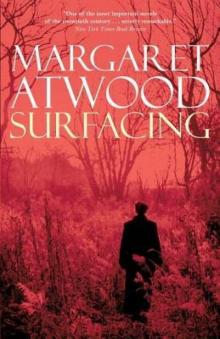 Surfacing
Surfacing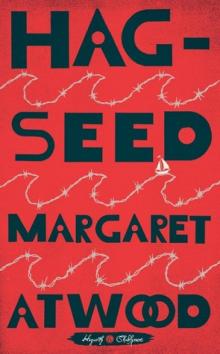 Hag-Seed
Hag-Seed Oryx and Crake
Oryx and Crake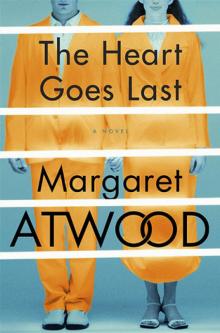 The Heart Goes Last
The Heart Goes Last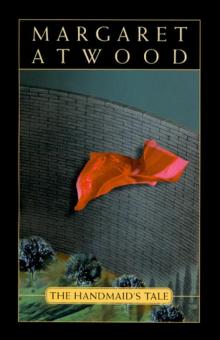 The Handmaid's Tale
The Handmaid's Tale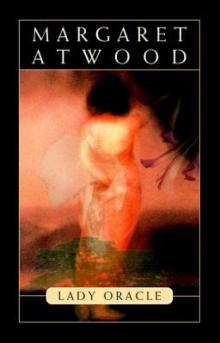 Lady Oracle
Lady Oracle Good Bones and Simple Murders
Good Bones and Simple Murders The Robber Bride
The Robber Bride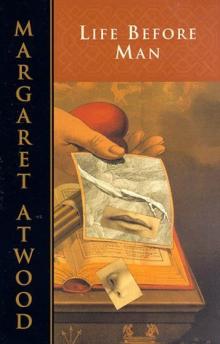 Life Before Man
Life Before Man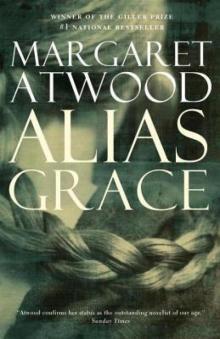 Alias Grace
Alias Grace The Blind Assassin
The Blind Assassin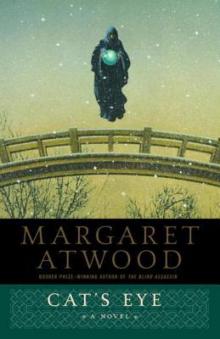 Cat's Eye
Cat's Eye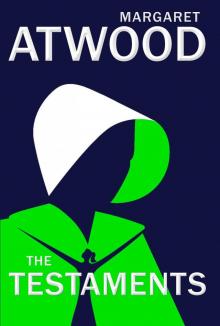 The Testaments
The Testaments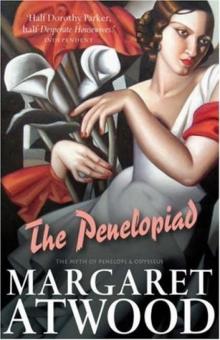 The Penelopiad
The Penelopiad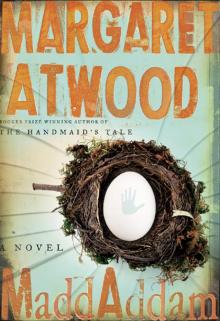 MaddAddam
MaddAddam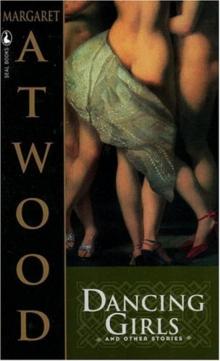 Dancing Girls & Other Stories
Dancing Girls & Other Stories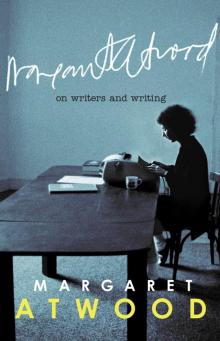 On Writers and Writing
On Writers and Writing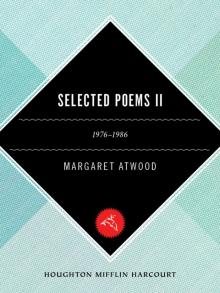 Selected Poems II (1976-1986)
Selected Poems II (1976-1986)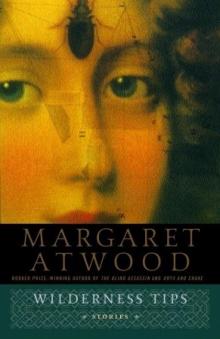 Wilderness Tips
Wilderness Tips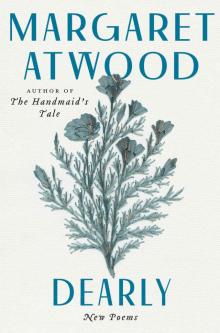 Dearly
Dearly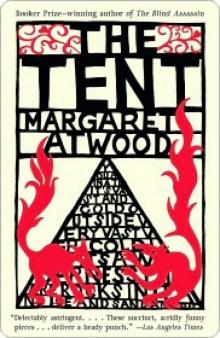 The Tent
The Tent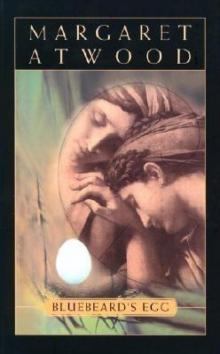 Bluebeard's Egg
Bluebeard's Egg The Edible Woman
The Edible Woman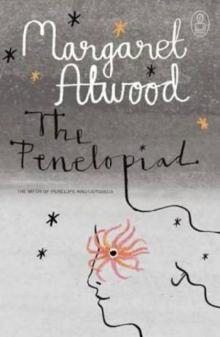 The Penelopiad: The Myth of Penelope and Odysseus
The Penelopiad: The Myth of Penelope and Odysseus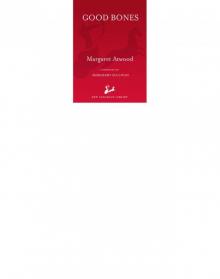 Good Bones
Good Bones I Dream of Zenia with the Bright Red Teeth
I Dream of Zenia with the Bright Red Teeth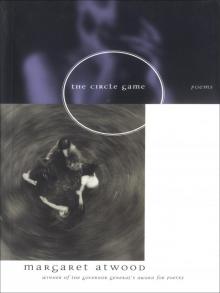 Circle Game
Circle Game Choke Collar: Positron, Episode Two
Choke Collar: Positron, Episode Two Stone Mattress: Nine Tales
Stone Mattress: Nine Tales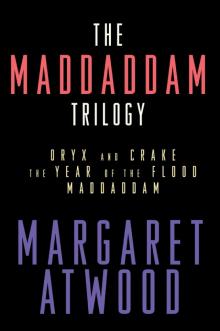 The MaddAddam Trilogy
The MaddAddam Trilogy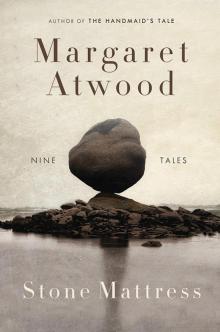 Stone Mattress
Stone Mattress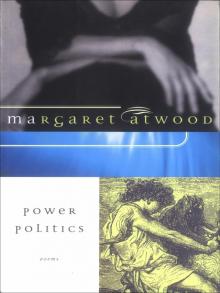 Power Politics
Power Politics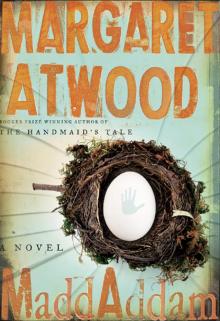 MaddAddam 03 - MaddAddam
MaddAddam 03 - MaddAddam I’m Starved for You (Kindle Single)
I’m Starved for You (Kindle Single)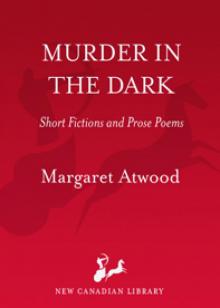 Murder in the Dark
Murder in the Dark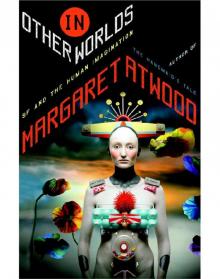 In Other Worlds
In Other Worlds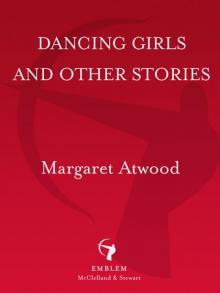 Dancing Girls
Dancing Girls Moral Disorder
Moral Disorder